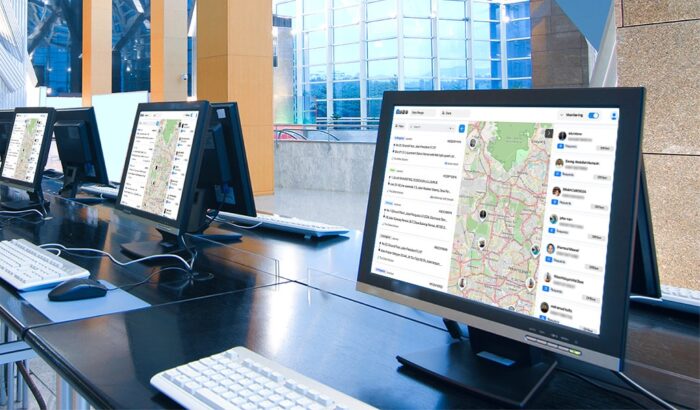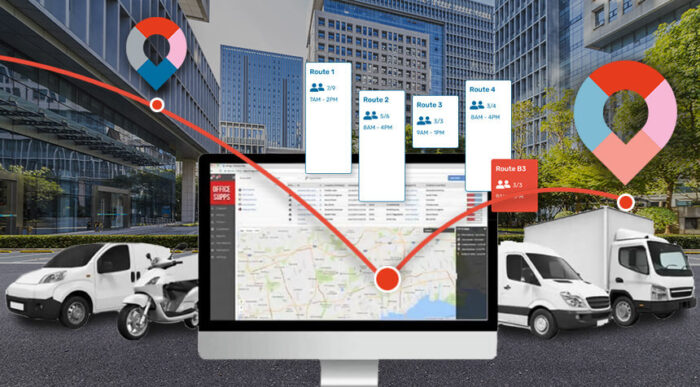
Most field service businesses operate at job sites that are remotely located from the main offices. To manage work, one had to hire separate managers, and supervisors or rely on customer feedback to know the performance of field service technicians.
Rather than spending separately on hiring, well-managed field service businesses use scheduling and dispatching software that includes mobile app availability as a feature. A mobile app makes managing remote field service teams much simpler and more real-time.
Read more to understand how mobile app-based dispatching software helps manage remote operations.

What is scheduling and dispatch software?
Scheduling and dispatch software helps field service businesses organize, manage, and assign tasks at a specific job site to field service technicians. Its primary role is involved in automating resource management and ensuring the tasks are completed as scheduled.
Some key features of scheduling and dispatch software include:
- Job scheduling: based on the task’s priority and the field service technician’s skillsets, availability, and location, the software matches the job with the right worker.
- Resource allocation: the software will allocate resources like equipment, vehicles, tools, software access, money, or manpower based on the job’s requirements. It helps minimize downtime for resources available.
- Real-time updating: using the software, it is easy to know real-time updates of field service technicians’ geo-location. It’s easy to share job information, priorities, or changes, while also communicating the same to customers.
- Customer communication: the software helps engage customers by updating them about assigned field service technicians and job status. It also helps collect customer feedback.
- Assignment of tasks: a single job may require multiple field service technicians. Dispatch software helps assign and manage tasks efficiently.

Why use a mobile application for dispatch software?
A meaningful way to ensure the above features are useful and implemented properly is to enable mobile app access. Here’s how it helps with better scheduling and dispatching operations:
Remote monitoring
With mobile-based software, your back-office team can communicate information about the job to field service technicians instantly. If you’re using a field service management app – Zuper, you get access to geo-fencing technology to track labor movements.
For example, using geo-fencing, your team can know the actual productive time for workers and detect the real-time location. In case they move out too much, teams can probe an inquiry into such behavior.
Real-time updates
Your project management team need not make frequent calls to field service technicians to know the project status with a mobile-based field service app.
For example, workers can instantly mark their attendance and leave on a mobile app. They can also request approval for leaves for their personal use. This eliminates any need for paperwork-based attendance tracking or delays in conveying important job scheduling-based decisions. With real-time updates, one gets an insight into worker performance to help them improve or solve problems on the go.
The same information gets easy to package and convey to customers. For example, you can share real-time updates with your clients about the status of the work. Such updates eliminate anxious calls from client teams about any work delays or status updates.

Better time management
With a mobile app, it is easy to share schedule details with field service technicians so that they can plan their work accordingly. They can also raise any concerns or requests regarding the schedule or potential delays. With GPS-enabled mapping, they can also plan their travel times and make sure deliveries are completed on time.
With the right information made available at the right time, one reduces delays caused due to improper planning. It enables field service technicians to focus on delivering rather than getting stuck on obtaining information to start or complete their job.
Accurate documentation and data capture
To check how well the work done by field service technicians aligns with the specifications, field service businesses have to spend money on quality assurance supervisors. This includes transportation, hourly wages, and time spent in conducting surprise visits. With mobile-based dispatch software, your workers can share images and timesheets instantly to report the work completed or pending. Thus, a field service business can save money.
Also, in case of emergencies, a supervisor or manager can suggest instant solutions or feedback to avoid blocking work.
A field service mobile app also makes capturing information easy from customers via feedback. For example, one can simply send a feedback form that helps gain on-ground insight into work completed by field service technicians. This is done by the popular ride-sharing app Uber – wherein they prompt users to share star-based ratings for both customers and drivers.

Make mobile-app a priority feature while selecting a dispatch software
A mobile app for dispatch software is not just a vitamin, but a painkiller for scheduling and dispatching workflows. It helps streamline and automate many manual tasks – thus saving time and money. Integrating a mobile app into dispatch software brings a multitude of benefits that enhance operational efficiency and optimize field service management.
The mobile app functionality enables real-time communication and collaboration between the back-office team and field service technicians, regardless of their physical locations. With just a few taps on their mobile devices, technicians can access work orders, view job details, and receive instant updates on task assignments and changes. This eliminates the need for phone calls or emails, enabling quicker response times and reducing miscommunications.
The mobile app also empowers technicians to provide real-time updates on job progress, including status updates, photos, and notes. This ensures that the entire team, including managers and clients, can stay informed about the latest developments and make informed decisions based on accurate and up-to-date information.
Furthermore, the mobile app enhances resource management by enabling technicians to view their schedules, access route optimization tools, and navigate to job sites efficiently. This leads to improved time management, reduced travel time, and optimized resource allocation. The app can also integrate with GPS tracking systems to monitor the real-time location of technicians, enabling dispatchers to make informed decisions and effectively respond to any changes or emergencies that may arise.











